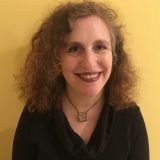As a Community Creative Fellow, I’ve been asked to reflect on the themes of Purim, specifically the themes of hidden identity and vulnerability, and consider how these themes emerge in my own artistic process.
To delve into this question, I go back in time to my childhood in México City, and my school uniform comes to mind. I went to a Jewish school, as did the majority of Jewish children, and our school’s sweater had a badge on the chest that included a Star of David with our school name embroidered on it. Once in a while I would run errands after school or go to the corner store with my sweater still on. While most of the time this did not pose a problem, what’s etched in my mind are those times when someone walked past me, looked at my sweater and said, “Pinche judía” [F#@*ing Jew] loud enough for me to hear. I never responded, too shocked by the comment and shaking with fear.
How could I not feel fear, knowing too well that my grandparents left Europe due to antisemitism, or knowing the history of the Holocaust, which I had been learning since my early years? I wonder why my school chose to include a Star of David as our school badge for all to see, and to place it in the exact same spot as the yellow Stars of David that Jews were forced to wear during the Nazi era. Surely it must have been a purposeful decision, a way to reclaim our Jewish identity, just as the LGBTQ community reclaimed the pink triangle after it was used as a badge of shame for homosexual and bisexual men in Nazi concentration camps.
When I moved to Dallas, Texas, at the age of 14, my Jewish identity moved to the background as my Mexican identity moved to the forefront, especially when folks heard my “accent” and asked where I was from. The racism against Mexicans was such that some of my classmates never spoke to me after I told them I was Mexican. And being Jewish didn’t open doors either. I was an outsider to the long-established Jewish Texan culture. Little by little my Jewish identity was limited to my private sphere.
A sense of vulnerability emerged with each of my identities, which was largely shaped by the contexts and circumstances of my geographies. I grew to learn that many people had a hard time understanding the fact that I could be both Mexican American/Latina and Jewish. It was not a “combination” most people had encountered, so they would often choose one identity over the other to define me, depending on their own perspectives, biases or needs (“Let’s count her as Latina for our demographics,” or, “She’s not really Latina because she’s Jewish!”).
While my “accent” shaped how others saw me and identified me as an outsider within the U.S. context, I could exercise some control over my Jewish identity. I could choose who I would tell I was Jewish. I shared it with the people who I thought would not discriminate and with those who I thought would understand or welcome my Latina Jewish identities. With the passing of time, it became too draining to explain how I could be Mexican American and Jewish, and I often had to use my instinct to determine whether the question came from a good place before investing time and energy explaining it and making myself vulnerable in the process.
These experiences have inevitably shaped my art practice. The concepts of identity and vulnerability weave themselves into my work as I tell stories of those who are invisible or marginalized. In the process, I often choose to reveal some elements while keeping others intentionally hidden. As I create work about my own family story, I wonder what work will emerge as I create work that addresses the intersection of my identities, a liminal state in which my Jewish, Mexican and Latina identities dance together.
This post has been contributed by a third party. The opinions, facts and any media content are presented solely by the author, and JewishBoston assumes no responsibility for them. Want to add your voice to the conversation? Publish your own post here. MORE



